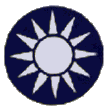China

Wei Chienmu
China

Wei Chienmu
Wei Chienmu served in the 32nd Fighter Squadron in August 1938. The squadron was at this time equipped with Gloster Gladiator Mk.Is.
By order of the staff, the Air Force on 29 August moved the 32nd PS with Gladiators under the command of the commander of the 3rd PG, Captain Wu Yu-Liu, to Nan Hsiung for defence against enemy air attacks.
At 09:50 on 30 August 1938, Nan Hsiung Command Post received a transmission that nine D1As had started from an airbase in Fujien to bomb Huizhou in the Guangdong Province. When it was confirmed that the D1As were crossing the Fujien/Jiangxi provincial border, Gladiators from the 3rd PG scrambled to intercept the enemy bombers. Once airborne the Gladiators divided into two formations. Captain Wu Yu-Liu led the first formation of five Gladiators while Zhu Jia-Xun, Squadron Leader of the 32nd Squadron, commanded the remaining four Gladiators. They were late, however, for at 10:30 the D1As had already completed their bomb run over Huizhou. It was estimated that over 30 bombs had been dropped creating extensive damage to the runway and the control building. When the Gladiators reached Huizhou, the D1As were already gone. Meanwhile military intelligence indicated that two more groups of enemy fighters and bombers were approaching Nan Hsiung. Wu thus led his Gladiators to report back to Nan Hsiung for CAP duties. While the Gladiators were racing for Nan Hsiung, the first group of 18 D1As arrived at Shaoguan at 10:50 to unload their bombs inflicting minor damage to the airbase facilities. The second group of eleven D1As escorted by an equal number of A5Ms reached Nan Hsiung at 10:40. The nine waiting Gladiators intercepted them. During the 45 minutes long combat Zhu Jia-Xun was credited with two victories while Squadron vice-commander Wei Dingleh and Wei Chienmu were credited with one victory each. Yang Yungjand and Tang Xingong each damaged an A5M. Japanese records shows that the Japanese Navy lost two pilots, Lieutenant Hideo Teshima (Class 58), Kaga's Division Officer, and PO2/c Seizaburo Sugino (Otsu 3). However the 32nd Squadron suffered heavily with the loss of six Gladiators. Capitain Wu Yu-Liu was killed in his Gladiator. Vice-commander Ma Yujen landed with a damaged Gladiator and a severe leg wound, and he later died in hospital due to his wounds. Zhu Jia-Xun crash-landed his Gladiator and was wounded in the left eye. Squadron vice-commander Wei Dingleh was forced to bail out of Gladiator no. 3206, which was written off. Wei Chienmu and Tang Xingong were both shot down by the Japanese fighters and they both were forced to leave their Gladiators in parachute. Yang Yungjan made an emergency landing on his return inflicting minor damage to his Gladiator. This meant that the Chinese Air Force only had three operational Gladiators left after this combat.
The Japanese force seems to have consisted of six A5Ms led by Lieutenant Teshima, five carrier based bombers and 4 carrier based attack planes from Kaga and the returning Japanese pilots claimed 17 Gladiators (Dewoitines and Hawks were also reported) for the loss of two pilots (Teshima and Sugino).
Jiro Chono, who served as leader of the 2nd shotai of the escort claimed three victories in this combat and one probable despite his aircraft had suffered fifteen hits. Two more Gladiators were claimed by Osamu Kudo.
Wei Chienmu ended the war with 1 biplane victory this one being claimed while flying Gloster Gladiator Mk.I.
Claims:
| Kill no. | Date | Number | Type | Result | Plane type | Serial no. | Locality | Unit |
| 1938 | ||||||||
| 1 | 30/08/38 | 1 | Enemy aircraft (a) | Destroyed | Gladiator I | Nan Hsiung | 32nd PS |
Biplane victories: 1 destroyed.
TOTAL: 1 destroyed.
(a) 32 Squadron claimed four aircraft in this combat. Japanese Navy lost two pilots; Lieutenant Hideo Teshima, Kaga's Division Officer, and PO2/c Seizaburo Sugino.
Sources:
Chinese Air Force Gladiators in Action - D. Y. Louie, 1998 Small Air Forces Observer vol. 22 no. 4 (88) December 1998 kindly provided by Santiago Flores.
Japanese Naval Aces and Fighter Units in World War II - Ikuhiko Hata and Yasuho Izawa, translated by Don Cyril Gorham, 1989 United States Naval Institute, Annapolis, ISBN 0-87021-315-6
Soviet Fighters in the sky of China, Part II - Anatolii Demin, 2000 Aviatsiia Kosmonavtika 10 (translated by George M. Mellinger)
Soviet Fighters in the sky of China, Part III - Anatolii Demin, 2000 Aviatsiia Kosmonavtika 11 (translated by George M. Mellinger)


